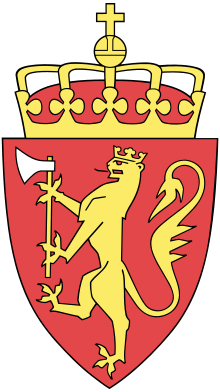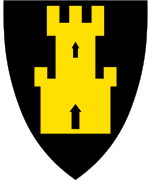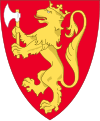Tromsø
Tromsø (/ˈtrɒmsoʊ/, also UK: /ˈtrɒmsɜː/;[3][4] Norwegian pronunciation: [ˈtrʊ̂msœ] (![]()
Tromsø kommune Romssa suohkan | |
|---|---|
.jpg) .jpg) .jpg) | |
 Coat of arms 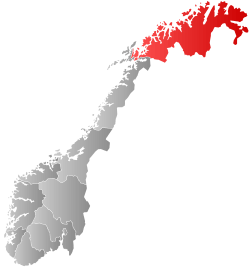 Troms og Finnmark within Norway | |
| Nickname(s): Nordens Paris (Paris of the North), Ishavsbyen | |
 Tromsø within Troms og Finnmark | |
| Coordinates: 69°40′58″N 18°56′34″E | |
| Country | Norway |
| County | Troms og Finnmark |
| District | Nord-Troms |
| Established | 1 Jan 1838 |
| Administrative centre | Tromsø |
| Government | |
| • Mayor (2019) | Gunnar Wilhelmsen (Ap) |
| Area | |
| • Total | 2,521.27 km2 (973.47 sq mi) |
| • Land | 2,473.78 km2 (955.13 sq mi) |
| • Water | 47.49 km2 (18.34 sq mi) 1.9% |
| Area rank | 21 in Norway |
| Population (30 September 2019) | |
| • Total | 76,974 |
| • Rank | 12 in Norway |
| • Density | 31.1/km2 (81/sq mi) |
| • Change (10 years) | 14.4% |
| Demonym(s) | Tromsøværing[1] |
| Time zone | UTC+01:00 (CET) |
| • Summer (DST) | UTC+02:00 (CEST) |
| ISO 3166 code | NO-5401 |
| Official language form | Neutral[2] |
| Website | tromso |
Tromsø lies in Northern Norway. The 2,521-square-kilometre (973 sq mi) municipality is the 21st largest by area out of the 356 municipalities in Norway. Tromsø is the 12th most populous municipality in Norway with a population of 76,974. The municipality's population density is 31.1 inhabitants per square kilometre (81/sq mi) and its population has increased by 14.4% over the previous 10-year period.[6][7] It is the largest urban area in Northern Norway and the third largest north of the Arctic Circle anywhere in the world (following Murmansk and Norilsk). Most of Tromsø, including the city centre, is located on the island of Tromsøya, 350 kilometres (217 mi) north of the Arctic Circle. In 2017, the city of Tromsø had a population of about 65,000 people spread out over Tromsøya and parts of Kvaløya and the mainland. Tromsøya is connected to the mainland by the Tromsø Bridge and the Tromsøysund Tunnel, and to the island of Kvaløya by the Sandnessund Bridge.
The municipality is warmer than most other places located on the same latitude, due to the warming effect of the Gulf Stream. Tromsø is even milder than places much farther south of it elsewhere in the world, such as on the Hudson Bay and in Far East Russia, with the warm-water current allowing for both relatively mild winters and tree growth in spite of its very high latitude.
The city centre of Tromsø contains the highest number of old wooden houses in Northern Norway, the oldest house dating from 1789. The city is a cultural centre for its region, with several festivals taking place in the summer. Torbjørn Brundtland and Svein Berge of the electronica duo Röyksopp and Lene Marlin grew up and started their careers in Tromsø. Noted electronic musician Geir Jenssen also hails from Tromsø.
Names and etymology
The city of Tromsø is named after the island of Tromsøya, on which it stands. The last element of the city's name comes from 'island' (Norwegian: øy, Danish: ø), but the etymology of the first element is uncertain. Several theories exist. One theory holds "Troms-" to derive from the old (uncompounded) name of the island (Old Norse: Trums). Several islands and rivers in Norway have the name Tromsa, and the names of these are probably derived from the word straumr which means "(strong) current". (The original form must then have been Strums, for the missing s see Indo-European s-mobile.) Another theory holds that Tromsøya was originally called Lille Tromsøya (Little Tromsøya), because of its proximity to the much bigger island today called Kvaløya, that according to this theory was earlier called "Store Tromsøya" due to a characteristic mountain known as Tromma (the Drum). The mountain's name in Sámi, Rumbbučohkka, is identical in meaning, and it is said to have been a sacred mountain for the Sámi in pre-Christian times.
The Sámi name of the island, Romsa, is assumed to be a loan from Norse - but according to the phonetical rules of the Sami language the frontal t has disappeared from the name. However, an alternative form - Tromsa - is in informal use. There is a theory that holds the Norwegian name of Tromsø derives from the Sámi name, though this theory lacks an explanation for the meaning of Romsa. A common misunderstanding is that Tromsø's Sámi name is Romssa with a double "s". This, however, is the accusative and genitive form of the noun used when, for example, writing "Tromsø Municipality" (Romssa Suohkan). In Finnish, however, the word is written with a double "s": Tromssa.
History
The area has been inhabited since the end of the ice age. Archeological excavations in Tønsvika, just outside the city limits, have turned up artifacts and remains of buildings estimated to be 9,000 to 10,000 years old.[8]
Middle Ages: a fortress on the frontier
The area's rich Norse and Sámi heritage is well documented. The Norse chieftain Ohthere, who lived during the 890s, is assumed to have inhabited the southernmost reaches of today's Tromsø municipality. He described himself as living "furthest to the North of all Norwegians" with areas north of this being populated by Sámi.[10] An Icelandic source (Rimbegla) from the 12th century also describes the fjord Malangen in the south of today's Tromsø municipality as a border between Norse and Sámi coastal settlements during that part of the Middle Ages. There has also been extensive Sámi settlement on the coast south of this 'border' as well as scattered Norse settlements north of Malangen—for example, both Sámi and Norse Iron Age (0–1050 AD) remains have been found on southern Kvaløya.[11][12]
The first church on the island of Tromsøya was erected in 1252. Ecclesia Sanctae Mariae de Trums juxta paganos ("The Church of Saint Mary in Troms near the Heathens"—the nominal "heathens" being the Sámi), was built during the reign of King Hákon Hákonarson.[13] At the time, it was the northernmost church in the world. Around the same time a turf rampart was built to protect the area against raids from Karelia and Russia.
Tromsø was not just a Norwegian outpost in an area mainly populated by the Sámi, but also a frontier city towards Russia; the Novgorod state had the right to tax the Sámi along the coast to Lyngstuva and inland to the Skibotn River or possibly the Målselv River, whereas Norway was allowed to tax areas east to - and including - the Kola Peninsula.[11] During the next five hundred years Norway's border with Russia and the limits of Norwegian settlement would be pushed eastwards to Sør-Varanger, making Tromsø lose its character as a "frontier town".
1700s and 1800s: the "Paris of the north"
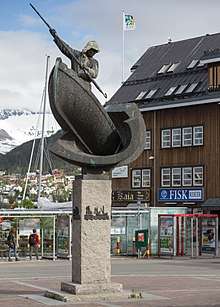
During the 17th century, while Denmark–Norway was solidifying its claim to the northern coast of Scandinavia and during this period a redoubt, Skansen, was built. Despite only being home to around 80 people, Tromsø was issued its city charter in 1794 by King Christian VII. This coincided with, and was a direct consequence of, the abolition of the city of Bergen's centuries-old monopoly on the trade in cod. Tromsø quickly rose in importance. The Diocese of Hålogaland was created in 1804, with the first bishop being Mathias Bonsak Krogh.[14] The city was established as a municipality 1 January 1838 (see formannskapsdistrikt).
Arctic hunting, from Novaya Zemlya to Canada, started up around 1820. By 1850, Tromsø was the major centre of Arctic hunting, overtaking the former centre of Hammerfest, and the city was trading from Arkhangelsk to Bordeaux.
In 1848, the teacher training college was also moved from Trondenes (near current-day Harstad) to Tromsø, with part of its mission being to educate Sámi scholars - there was a quota ensuring that Sámi gained access.[15] The teacher college was followed by the Tromsø Museum in 1872,[16] and the Mack Brewery in 1877.[17]
During the 19th century, Tromsø became known as the "Paris of the North". How this nickname came into being is uncertain, but the reason is generally assumed to be that people in Tromsø appeared far more sophisticated than visitors from the south typically expected.[18]
Early 1900s: exploration and war
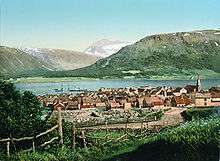
By the end of the 19th century, Tromsø had become a major Arctic trade centre from which many Arctic expeditions originated. Explorers like Roald Amundsen, Umberto Nobile and Fridtjof Nansen made use of the know-how in Tromsø on the conditions in the Arctic, and often recruited their crews in the city.[19][20] The Northern lights observatory was founded in 1927.
When Germany invaded Norway in 1940, Tromsø served briefly as the seat of the Norwegian government. General Carl Gustav Fleischer arrived in Tromsø on 10 April 1940 after flying in terrible conditions. From Tromsø he issued orders for total civilian and military mobilisation and declared Northern Norway a theatre of war. Fleischer's strategic plan was to first wipe out the German forces at Narvik and then transfer his division to Nordland to meet a German advance from Trøndelag. The Germans eventually captured all of Norway, after allied support had been withdrawn, although they encountered fierce resistance from the Finnmark-based Alta Battalion at Narvik. Tromsø escaped the war unscathed, although the German battleship Tirpitz was sunk by RAF Avro Lancaster bombers[21] during Operation Catechism off the Tromsøy island on 12 November 1944, killing close to 1,000 German sailors.[22][23]
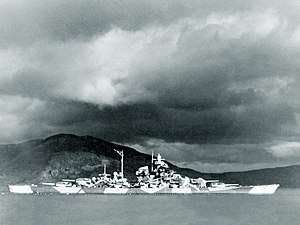
At the end of the war, the city received thousands of refugees from Finnmark county and the North Troms area - which had been devastated by German forces using scorched earth tactics in expectation of the Red Army offensive.[24]
Late 1900s – today: rapid expansion
Expansion after World War II has been rapid. The rural municipalities of Tromsøysund and Ullsfjord, and most of Hillesøy, were merged with Tromsø on 1 January 1964, creating today's Tromsø municipality and almost tripling Tromsø's population - from 12,430 to 32,664.[25] In addition, the population growth has been strong, with at times more than 1,000 new Tromsøværinger (residents of Tromsø) annually. The population of Tromsø municipality today is 68,239, and the urban area, Norway's ninth most populous, is home to 58,486 people.[26] This excludes most of the city's students, however, who often do not change their address when moving to Tromsø.
A major development was the opening of Tromsø Airport in 1964, situated on the main island, and in 1972 the University of Tromsø was opened, at the time one of four universities in Norway and the only one serving the northern half of the country. A local teacher's college and museum were eventually incorporated into the university. The Norwegian Polar Institute was moved to Tromsø from Oslo in 1998. More recently, the university has expanded further through two mergers, first with University College Tromsø in 2009 and then with University College Finnmark in 2013.
Municipal history
The city of Tromsø was established as an independent municipality on 1 January 1838 (see formannskapsdistrikt). The city was completely surrounded by the Tromsøe landdistrikt (the rural municipality of Tromsø / later renamed Tromsøysund), but they were governed separately. As the city grew in size, areas were added to the city from the rural district.[27]
On 1 January 1861, an area of Tromsøysund (population: 110) was transferred to the city of Tromsø. On 1 January 1873, an unpopulated area of Tromsøysund was transferred to the city. On 1 July 1915, another area of Tromsøysund (population: 512) was merged into the city of Tromsø. On 1 January 1955, the Bjerkaker area on Tromsøya (population: 1,583) was transferred from Tromsøysund to the city of Tromsø.[27]
During the 1960s, there were many municipal mergers across Norway due to the work of the Schei Committee. On 1 January 1964, the city of Tromsø (population: 12,602), the municipality of Tromsøysund (population: 16,727), most of the municipality of Ullsfjord except for the Svendsby area (population: 2,019), and most of the municipality of Hillesøy except for the parts on the island of Senja (population: 1,316) were all merged to form a new, larger Tromsø Municipality.[27]
On 1 January 2020, the municipality became a part of the newly created Troms og Finnmark county, which replaced the old Troms county.
Coat of arms
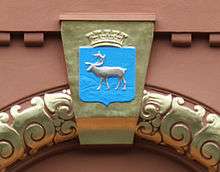
The coat of arms of Tromsø was devised in 1870 and is blazoned "Azure, a reindeer trippant Argent."[28] It is often surmounted by a mural crown with five or four turrets. The municipal authority currently uses a stylised rendering drawn by Hallvard Trætteberg (1898–1987) and adopted by royal resolution on 24 September 1941.[29][30]
Geography
Tromsø is the eighth-largest municipality in Norway with a population of 71,590, and the centre of the ninth-largest urban area, with a population of about 65,000. The city is home to the world's northernmost university and also houses the northernmost botanical garden[31] and planetarium.[32]
The city centre is located on the east side of the Tromsøya island — over 300 kilometres (190 mi) north of the Arctic Circle at 69°40′33″N 18°55′10″E. Suburban areas include Kroken, Tromsdalen (on the mainland, east of Tromsøya), the rest of the Tromsøya island, and the eastern part of the large Kvaløya, west of the Tromsøya island. The Tromsø Bridge and Tromsøysund Tunnel both cross the Tromsøysundet strait connecting the mainland with Tromsøya by road. On the western side of the city, the Sandnessund Bridge connects Tromsøya island with Kvaløya island.
There are many tall mountains within the municipality including Hamperokken, Jiehkkevárri, Store Blåmann, Store Fornestinden, and Tromsdalstinden. The Lyngen Alps mountain range lies along the Tromsø-Lyngen municipal border. There are many islands within the municipality of Tromsø including Hillesøya, Kvaløya, Rebbenesøya, Ringvassøya, Sommarøya, and Tromsøya. There are also several fjords that are located in Tromsø including the Balsfjorden, Kaldfjorden, Malangen, and Ullsfjorden.
Climate
Tromsø experiences a subarctic climate (Köppen climate classification (Dfc) as winter temperatures are just cold enough to qualify and the summer season is short. However, precipitation amount and pattern, with maximum precipitation in autumn and early winter, as well as lack of permafrost, are atypical for subarctic areas. Due to the ice-free Norwegian Sea and the westerlies bringing the mild air ashore, winter temperatures in Tromsø are moderated and extremely mild for the latitude. The climate could more accurately be described as "continental maritime" than a typical subarctic climate.
Tromsø has reputation of accumulating a lot of snow in winter, but on the streets of the city ice often prevails, especially in the first half of the winter. Tromsø's snowfall pattern is quite erratic and varies substantially between different winters.[33] Thaws with rain in the polar night mid-winter are not uncommon, which melts or wets existing snow, often followed by chilly windy Arctic blasts, creating dangerous ice driving and walking conditions. It is common to see Tromsø inhabitants walking with spikes in their shoes and almost all cars use studded tires. The all-time record for snow depth was set on 29 April 1997, when the meteorological station on top of Tromsøya recorded 240 centimetres (94.5 in) of snow on the ground.[34] In an average winter, Tromsø sees 160 days with at least 25 centimetres (10 in) of snow on the ground (based on 1970–2000 average and recorded at the meteorological office station on top of the island, 100 meters above sea level).[35]
The lowest temperature ever recorded is −18.4 °C (−1.1 °F) in February 1966.[34] That is extremely mild for a location this far north, as it is about the same as the record cold for the entire state of Florida—about 40 degrees latitude further south. However, at the airport, also in the city, the lowest ever recording is −20.1 °C (−4.2 °F) in February 1985.[36] Despite being a full 10 degrees further north than the Norwegian capital, Oslo, winter temperatures are very similar. The "midnight sun" is above the horizon from 19 May to 27 July (71 days), and the period with continuous night lasts a bit shorter, polar night from 28 November to 14 January (48 days).
Summers are rather cool, sometimes cloudy and rainy, and sometimes sunny, often with large variations from year to year and from month to month, depending on the weather pattern. However, for its latitude its summers are fairly warm, especially for a maritime location. Tromsø has recorded the sunniest month ever in Norway with 430 sunhours in July 1980, and also the sunniest spring month with 381 sunhours in May 2013.[34] The highest temperature ever recorded at the met office 100 m amsl is 30.2 °C (86.4 °F) in July 1972. Outside the city, large areas in the municipality are above the treeline and have an alpine tundra climate. On the west coast of Kvaløya (Sommarøy), climate data show a mean annual temperature of 3.9 °C (39.0 °F), mostly because winters here are 2 °C (4 °F) warmer compared to the city,[37] making this part of the municipality a subpolar oceanic climate (Cfc) zone. Tromsø has the distinction of being the northernmost city on earth where the average yearly low is above freezing.
Recent years have seen warming, and there have been no overnight air frost in June since 1997.
| Climate data for Tromsø, Norway 1981 - 2010, sunshine 1961 - 1990, extremes 1920 - present (100 m) | |||||||||||||
|---|---|---|---|---|---|---|---|---|---|---|---|---|---|
| Month | Jan | Feb | Mar | Apr | May | Jun | Jul | Aug | Sep | Oct | Nov | Dec | Year |
| Record high °C (°F) | 8.4 (47.1) |
8.2 (46.8) |
9.1 (48.4) |
17 (63) |
26.6 (79.9) |
29.5 (85.1) |
30.2 (86.4) |
28.4 (83.1) |
22.4 (72.3) |
18.6 (65.5) |
11.9 (53.4) |
9.7 (49.5) |
30.2 (86.4) |
| Average high °C (°F) | −1.3 (29.7) |
−1.4 (29.5) |
0.2 (32.4) |
3.5 (38.3) |
8.2 (46.8) |
12.7 (54.9) |
15.8 (60.4) |
14.5 (58.1) |
10.0 (50.0) |
5.0 (41.0) |
1.3 (34.3) |
−0.5 (31.1) |
5.7 (42.3) |
| Daily mean °C (°F) | −3.5 (25.7) |
−3.7 (25.3) |
−2.2 (28.0) |
0.9 (33.6) |
5.3 (41.5) |
9.4 (48.9) |
12.4 (54.3) |
11.3 (52.3) |
7.4 (45.3) |
2.9 (37.2) |
−0.7 (30.7) |
−2.6 (27.3) |
3.1 (37.6) |
| Average low °C (°F) | −5.6 (21.9) |
−5.9 (21.4) |
−4.6 (23.7) |
−1.8 (28.8) |
2.3 (36.1) |
6.1 (43.0) |
8.9 (48.0) |
8.0 (46.4) |
4.8 (40.6) |
0.8 (33.4) |
−2.6 (27.3) |
−4.8 (23.4) |
0.5 (32.9) |
| Record low °C (°F) | −18.3 (−0.9) |
−18.4 (−1.1) |
−17.0 (1.4) |
−14.3 (6.3) |
−6.6 (20.1) |
−2.5 (27.5) |
0.7 (33.3) |
1.1 (34.0) |
−4.3 (24.3) |
−9.6 (14.7) |
−14.2 (6.4) |
−16.8 (1.8) |
−18.4 (−1.1) |
| Average precipitation mm (inches) | 112.4 (4.43) |
95.4 (3.76) |
71.7 (2.82) |
66.1 (2.60) |
57.4 (2.26) |
54.1 (2.13) |
77.8 (3.06) |
86.6 (3.41) |
110.9 (4.37) |
135.9 (5.35) |
98.3 (3.87) |
112.3 (4.42) |
1,080.8 (42.55) |
| Average precipitation days (≥ 1 mm) | 15.4 | 12.9 | 11.4 | 11.6 | 11.1 | 10.3 | 12.8 | 12.6 | 14.9 | 17.7 | 13.5 | 15.6 | 160.1 |
| Mean monthly sunshine hours | 3 | 32 | 112 | 160 | 218 | 221 | 205 | 167 | 92 | 49 | 6 | 0 | 1,265 |
| Average ultraviolet index | 0 | 0 | 1 | 2 | 3 | 3 | 3 | 2 | 1 | 0 | 0 | 0 | 1 |
| Source 1: Met Norway,[34][38] The Weather Network,[39] Météo climat stats[40] | |||||||||||||
| Source 2: Weather Atlas[41] (UV index) | |||||||||||||
| Climate data for Tromsø | |||||||||||||
|---|---|---|---|---|---|---|---|---|---|---|---|---|---|
| Month | Jan | Feb | Mar | Apr | May | Jun | Jul | Aug | Sep | Oct | Nov | Dec | Year |
| Average sea temperature °C (°F) | 5.2 (41.4) |
4.6 (40.3) |
4.2 (39.5) |
4.6 (40.3) |
6.2 (43.1) |
8.8 (47.8) |
10.8 (51.4) |
11.3 (52.4) |
10.1 (50.3) |
8.3 (47.0) |
7.6 (45.6) |
6.4 (43.6) |
7.3 (45.2) |
| Source: Weather Atlas[41] | |||||||||||||
Light and darkness
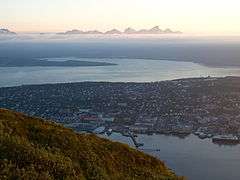
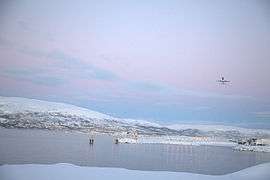
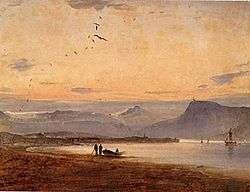
The midnight sun occurs from about 18 May to 26 July, but mountains block the view of it for a few days, meaning that one can see the midnight sun from about 21 May to 21 July. Due to Tromsø's high latitude, twilight is long, meaning there is no true night between March 27 and September 17.
The sun remains below the horizon during the polar night from about 26 November to 15 January, but due to the mountains, the sun is not visible from 21 November to 21 January. The return of the sun is an occasion for celebration. However, because of the twilight, there is some daylight for a couple of hours even around midwinter, often with bluish light, allowing for normal day/night cycles during the winter. The nights shorten quickly. By 21 February, the sun is above the horizon from 7:45 am to 4:10 pm and, by 1 April, is above the horizon from 5:50 am to 7:50 pm (daylight saving time). However, if one were to include astronomical twilight as "not night", then Tromsø only has 13 hours and 32 minutes of night on the winter solstice.
The combination of snow cover and sunshine often creates intense light conditions from late February until the snow melts in the lowland (usually late April), and sunglasses are essential when skiing. Because of these diametrically different light conditions in winter, Norwegians often divide it into two seasons: Mørketid (polar night) and Seinvinter (late winter).
It is possible to observe the aurora borealis (northern lights) from Tromsø, as northern Norway is located in the auroral zone. As it is always light in the summer, no aurora is visible between late April and mid August. Additionally, due to the coastal location, Tromsø is often subject to cloudy conditions, which prevent aurorae being seen, even if they are present.
Villages
Tromsø municipality includes these villages:
| Kvaløya | City of Tromsø Tromsøya | Mainland |
|---|---|---|
|
|
Cityscape
.jpg)
The compact city centre has the biggest concentration of historic wooden houses north of Trondheim, and they co-exist with modern architecture. The houses date from 1789 to 1904, when building wooden houses was banned in the city centre, as in several other Norwegian cities. The oldest house in Tromsø is Skansen, built in 1789 on the remains of a 13th-century turf rampart.[42][43]
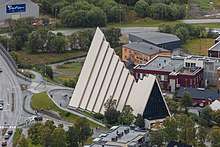
The Polar Museum, Polarmuseet, situated in a wharf house from 1837, presents Tromsø's past as a centre for Arctic hunting and starting point for Arctic expeditions. Tromsø Cathedral, Norway's only wooden cathedral, built in 1861, is located in the middle of the city, and so is the small Catholic church Vår Frue ("Our Lady"). Northern Europe's oldest cinema still in use, Verdensteatret, was built in 1915–16. The cinema has large wall paintings, made by the local artist Sverre Mack in 1921, which picture scenes from Norwegian folk lore and fairy tales.
The Arctic Cathedral, a modern church built in 1965, is situated on the mainland, facing the sound and city centre. The church, in reality a parish church and not a cathedral, was drawn by Jan Inge Hovig. The Polaria aquarium and experience centre from 1998 is a short walk south from the city centre. The Tromsø Museum is a university museum, presenting culture and nature of North Norway. The museum also displays the Arctic-alpine botanic garden, the world's northernmost botanical garden. A cable car goes up to mount Storsteinen, 420 metres (1,380 feet) above sea level, with a panoramic view over Tromsø. The mountain Tromsdalstinden, 1,238 metres (4,062 ft), on the mainland, which is easily spotted from the city centre, is also a major landmark. At the top of Tromsøya is a lake called Prestvannet.
Churches
The Church of Norway has eight parishes (sokn) within the municipality of Tromsø. It is part of the Tromsø domprosti (arch-deanery) in the Diocese of Nord-Hålogaland.
| Parish (Sokn) | Church Name | Location of the Church | Year Built |
|---|---|---|---|
| Tromsø Domkirken | Tromsø Cathedral | Tromsø | 1861 |
| Elverhøy | Elverhøy Church | Tromsø | 1803 |
| Grønnåsen | Grønnåsen Church | Tromsø | 1996 |
| Hillesøy | Hillesøy Church | Brensholmen, Kvaløya | 1889 |
| Kroken | Kroken Church | Kroken | 2006 |
| Kvaløy | Kvaløy Church | Kaldfjord | 1962 |
| Tromsøysund | Arctic Cathedral | Tromsdalen | 1965 |
| Ullsfjord | Lakselvbukt Church | Lakselvbukt | 1983 |
| Ullsfjord Church | Sjursnes | 1862 | |
| Jøvik Chapel | Jøvik | 1920 |
Government
All municipalities in Norway, including Tromsø, are responsible for primary education (through 10th grade), outpatient health services, senior citizen services, unemployment and other social services, zoning, economic development, and municipal roads. The municipality is governed by a municipal council of elected representatives, which in turn elect a mayor.[44] The municipality falls under the Nord-Troms District Court and the Hålogaland Court of Appeal.
Municipal council
The municipal council (Kommunestyre) of Tromsø is made up of 43 representatives that are elected to four year terms. Tromsø introduced so-called "parliamentary rule" in 2011. The Municipal council elects an executive body, byrådet ("the city council"), consisting of six byråder ("city councilors"). At least in theory, these are equivalent to the cabinet members of a parliamentary government. The party breakdown of the council is as follows:
| Party Name (in Norwegian) | Number of representatives | |
|---|---|---|
| Labour Party (Arbeiderpartiet) | 8 | |
| People's Action No to More Road Tolls (Folkeaksjonen nei til mer bompenger) | 4 | |
| Progress Party (Fremskrittspartiet) | 4 | |
| Green Party (Miljøpartiet De Grønne) | 3 | |
| Conservative Party (Høyre) | 7 | |
| Christian Democratic Party (Kristelig Folkeparti) | 1 | |
| Red Party (Rødt) | 2 | |
| Centre Party (Senterpartiet) | 5 | |
| Socialist Left Party (Sosialistisk Venstreparti) | 7 | |
| Liberal Party (Venstre) | 1 | |
| City and Rural List (By- og Landlista) | 1 | |
| Total number of members: | 43 | |
| Party Name (in Norwegian) | Number of representatives | |
|---|---|---|
| Labour Party (Arbeiderpartiet) | 13 | |
| Progress Party (Fremskrittspartiet) | 5 | |
| Green Party (Miljøpartiet De Grønne) | 2 | |
| Conservative Party (Høyre) | 9 | |
| Christian Democratic Party (Kristelig Folkeparti) | 1 | |
| Red Party (Rødt) | 6 | |
| Centre Party (Senterpartiet) | 1 | |
| Socialist Left Party (Sosialistisk Venstreparti) | 4 | |
| Liberal Party (Venstre) | 2 | |
| Total number of members: | 43 | |
| Party Name (in Norwegian) | Number of representatives | |
|---|---|---|
| Labour Party (Arbeiderpartiet) | 11 | |
| Progress Party (Fremskrittspartiet) | 6 | |
| Green Party (Miljøpartiet De Grønne) | 1 | |
| Conservative Party (Høyre) | 16 | |
| Christian Democratic Party (Kristelig Folkeparti) | 1 | |
| Red Party (Rødt) | 3 | |
| Centre Party (Senterpartiet) | 1 | |
| Socialist Left Party (Sosialistisk Venstreparti) | 2 | |
| Liberal Party (Venstre) | 2 | |
| Total number of members: | 43 | |
| Party Name (in Norwegian) | Number of representatives | |
|---|---|---|
| Labour Party (Arbeiderpartiet) | 17 | |
| Progress Party (Fremskrittspartiet) | 9 | |
| Conservative Party (Høyre) | 5 | |
| Christian Democratic Party (Kristelig Folkeparti) | 2 | |
| Red Electoral Alliance (Rød Valgallianse) | 4 | |
| Centre Party (Senterpartiet) | 1 | |
| Socialist Left Party (Sosialistisk Venstreparti) | 3 | |
| Total number of members: | 43 | |
| Party Name (in Norwegian) | Number of representatives | |
|---|---|---|
| Labour Party (Arbeiderpartiet) | 13 | |
| Progress Party (Fremskrittspartiet) | 8 | |
| Conservative Party (Høyre) | 5 | |
| Christian Democratic Party (Kristelig Folkeparti) | 2 | |
| Coastal Party (Kystpartiet) | 1 | |
| Red Electoral Alliance (Rød Valgallianse) | 1 | |
| Centre Party (Senterpartiet) | 1 | |
| Socialist Left Party (Sosialistisk Venstreparti) | 10 | |
| Liberal Party (Venstre) | 1 | |
| Parents' List (Foreldre lista) | 1 | |
| Total number of members: | 43 | |
| Party Name (in Norwegian) | Number of representatives | |
|---|---|---|
| Labour Party (Arbeiderpartiet) | 21 | |
| Progress Party (Fremskrittspartiet) | 6 | |
| Conservative Party (Høyre) | 10 | |
| Christian Democratic Party (Kristelig Folkeparti) | 3 | |
| Red Electoral Alliance (Rød Valgallianse) | 2 | |
| Centre Party (Senterpartiet) | 2 | |
| Socialist Left Party (Sosialistisk Venstreparti) | 6 | |
| Liberal Party (Venstre) | 2 | |
| Solidarity (Solidaritet) | 1 | |
| Total number of members: | 53 | |
| Party Name (in Norwegian) | Number of representatives | |
|---|---|---|
| Labour Party (Arbeiderpartiet) | 21 | |
| Progress Party (Fremskrittspartiet) | 5 | |
| Green Party (Miljøpartiet De Grønne) | 1 | |
| Conservative Party (Høyre) | 16 | |
| Christian Democratic Party (Kristelig Folkeparti) | 4 | |
| Red Electoral Alliance (Rød Valgallianse) | 4 | |
| Centre Party (Senterpartiet) | 4 | |
| Socialist Left Party (Sosialistisk Venstreparti) | 8 | |
| Liberal Party (Venstre) | 2 | |
| Solidarity (Solidaritet) | 4 | |
| Total number of members: | 69 | |
| Party Name (in Norwegian) | Number of representatives | |
|---|---|---|
| Labour Party (Arbeiderpartiet) | 17 | |
| Progress Party (Fremskrittspartiet) | 2 | |
| Conservative Party (Høyre) | 25 | |
| Christian Democratic Party (Kristelig Folkeparti) | 3 | |
| Red Electoral Alliance (Rød Valgallianse) | 2 | |
| Centre Party (Senterpartiet) | 4 | |
| Socialist Left Party (Sosialistisk Venstreparti) | 14 | |
| Liberal Party (Venstre) | 2 | |
| Total number of members: | 69 | |
| Party Name (in Norwegian) | Number of representatives | |
|---|---|---|
| Labour Party (Arbeiderpartiet) | 23 | |
| Progress Party (Fremskrittspartiet) | 5 | |
| Conservative Party (Høyre) | 25 | |
| Christian Democratic Party (Kristelig Folkeparti) | 3 | |
| Red Electoral Alliance (Rød Valgallianse) | 4 | |
| Centre Party (Senterpartiet) | 1 | |
| Socialist Left Party (Sosialistisk Venstreparti) | 6 | |
| Liberal Party (Venstre) | 2 | |
| Total number of members: | 69 | |
| Party Name (in Norwegian) | Number of representatives | |
|---|---|---|
| Labour Party (Arbeiderpartiet) | 25 | |
| Progress Party (Fremskrittspartiet) | 3 | |
| Conservative Party (Høyre) | 23 | |
| Christian Democratic Party (Kristelig Folkeparti) | 4 | |
| Red Electoral Alliance (Rød Valgallianse) | 4 | |
| Centre Party (Senterpartiet) | 1 | |
| Socialist Left Party (Sosialistisk Venstreparti) | 6 | |
| Liberal Party (Venstre) | 3 | |
| Total number of members: | 69 | |
| Party Name (in Norwegian) | Number of representatives | |
|---|---|---|
| Labour Party (Arbeiderpartiet) | 22 | |
| Progress Party (Fremskrittspartiet) | 1 | |
| Conservative Party (Høyre) | 24 | |
| Christian Democratic Party (Kristelig Folkeparti) | 6 | |
| Red Electoral Alliance (Rød Valgallianse) | 3 | |
| Centre Party (Senterpartiet) | 3 | |
| Socialist Left Party (Sosialistisk Venstreparti) | 5 | |
| Liberal Party (Venstre) | 5 | |
| Total number of members: | 69 | |
| Party Name (in Norwegian) | Number of representatives | |
|---|---|---|
| Labour Party (Arbeiderpartiet) | 25 | |
| Anders Lange's Party (Anders Langes parti) | 1 | |
| Conservative Party (Høyre) | 14 | |
| Christian Democratic Party (Kristelig Folkeparti) | 8 | |
| New People's Party (Nye Folkepartiet) | 3 | |
| Red Electoral Alliance (Rød Valgallianse) | 1 | |
| Centre Party (Senterpartiet) | 6 | |
| Socialist Left Party (Sosialistisk Venstreparti) | 6 | |
| Liberal Party (Venstre) | 5 | |
| Total number of members: | 69 | |
| Party Name (in Norwegian) | Number of representatives | |
|---|---|---|
| Labour Party (Arbeiderpartiet) | 30 | |
| Conservative Party (Høyre) | 10 | |
| Christian Democratic Party (Kristelig Folkeparti) | 4 | |
| Centre Party (Senterpartiet) | 5 | |
| Socialist People's Party (Sosialistisk Folkeparti) | 5 | |
| Liberal Party (Venstre) | 12 | |
| Socialist common list (Venstresosialistiske felleslister) | 3 | |
| Total number of members: | 69 | |
| Party Name (in Norwegian) | Number of representatives | |
|---|---|---|
| Labour Party (Arbeiderpartiet) | 37 | |
| Conservative Party (Høyre) | 10 | |
| Communist Party (Kommunistiske Parti) | 1 | |
| Christian Democratic Party (Kristelig Folkeparti) | 2 | |
| Centre Party (Senterpartiet) | 2 | |
| Socialist People's Party (Sosialistisk Folkeparti) | 4 | |
| Liberal Party (Venstre) | 13 | |
| Total number of members: | 69 | |
| Party Name (in Norwegian) | Number of representatives | |
|---|---|---|
| Labour Party (Arbeiderpartiet) | 36 | |
| Conservative Party (Høyre) | 12 | |
| Communist Party (Kommunistiske Parti) | 1 | |
| Christian Democratic Party (Kristelig Folkeparti) | 3 | |
| Centre Party (Senterpartiet) | 1 | |
| Socialist People's Party (Sosialistisk Folkeparti) | 2 | |
| Liberal Party (Venstre) | 14 | |
| Total number of members: | 69 | |
| Party Name (in Norwegian) | Number of representatives | |
|---|---|---|
| Labour Party (Arbeiderpartiet) | 26 | |
| Conservative Party (Høyre) | 10 | |
| Communist Party (Kommunistiske Parti) | 3 | |
| Christian Democratic Party (Kristelig Folkeparti) | 2 | |
| Liberal Party (Venstre) | 12 | |
| Total number of members: | 53 | |
| Party Name (in Norwegian) | Number of representatives | |
|---|---|---|
| Labour Party (Arbeiderpartiet) | 24 | |
| Conservative Party (Høyre) | 8 | |
| Communist Party (Kommunistiske Parti) | 4 | |
| Christian Democratic Party (Kristelig Folkeparti) | 3 | |
| Liberal Party (Venstre) | 14 | |
| Total number of members: | 53 | |
| Party Name (in Norwegian) | Number of representatives | |
|---|---|---|
| Labour Party (Arbeiderpartiet) | 24 | |
| Conservative Party (Høyre) | 7 | |
| Communist Party (Kommunistiske Parti) | 4 | |
| Liberal Party (Venstre) | 17 | |
| Total number of members: | 52 | |
| Party Name (in Norwegian) | Number of representatives | |
|---|---|---|
| Labour Party (Arbeiderpartiet) | 22 | |
| Conservative Party (Høyre) | 6 | |
| Communist Party (Kommunistiske Parti) | 6 | |
| Liberal Party (Venstre) | 18 | |
| Total number of members: | 52 | |
| Party Name (in Norwegian) | Number of representatives | |
|---|---|---|
| Labour Party (Arbeiderpartiet) | 24 | |
| Conservative Party (Høyre) | 5 | |
| Communist Party (Kommunistiske Parti) | 8 | |
| Liberal Party (Venstre) | 15 | |
| Total number of members: | 52 | |
| Party Name (in Norwegian) | Number of representatives | |
|---|---|---|
| Labour Party (Arbeiderpartiet) | 21 | |
| Conservative Party (Høyre) | 12 | |
| Communist Party (Kommunistiske Parti) | 2 | |
| Liberal Party (Venstre) | 17 | |
| Total number of members: | 52 | |
| Party Name (in Norwegian) | Number of representatives | |
|---|---|---|
| Labour Party (Arbeiderpartiet) | 22 | |
| Conservative Party (Høyre) | 13 | |
| Communist Party (Kommunistiske Parti) | 3 | |
| Liberal Party (Venstre) | 14 | |
| Total number of members: | 52 | |
| Party Name (in Norwegian) | Number of representatives | |
|---|---|---|
| Labour Party (Arbeiderpartiet) | 15 | |
| Communist Party (Kommunistiske Parti) | 5 | |
| Liberal Party (Venstre) | 15 | |
| Joint list of the Conservative Party (Høyre) and the Free-minded People's Party (Frisinnede Folkeparti) | 11 | |
| Joint List(s) of Non-Socialist Parties (Borgerlige Felleslister) | 3 | |
| Local List(s) (Lokale lister) | 3 | |
| Total number of members: | 52 | |
| Party Name (in Norwegian) | Number of representatives | |
|---|---|---|
| Labour Party (Arbeiderpartiet) | 20 | |
| Communist Party (Kommunistiske Parti) | 4 | |
| Radical People's Party (Radikale Folkepartiet) | 3 | |
| Liberal Party (Venstre) | 12 | |
| Joint list of the Conservative Party (Høyre) and the Free-minded Liberal Party (Frisinnede Venstre) | 13 | |
| Total number of members: | 52 | |
| Party Name (in Norwegian) | Number of representatives | |
|---|---|---|
| Labour Party (Arbeiderpartiet) | 10 | |
| Social Democratic Labour Party (Socialdemokratiske Arbeiderparti) | 2 | |
| Tromsø Workers Party (Tromsø Arbeiderparti) | 3 | |
| Joint list of the Conservative Party (Høyre) and the Free-minded Liberal Party (Frisinnede Venstre) | 15 | |
| Joint list of the Radical People's Party (Radikale Folkepartiet) and the Liberal Party (Venstre) | 17 | |
| Workers' Common List (Arbeidernes fellesliste) | 5 | |
| Total number of members: | 52 | |
| Party Name (in Norwegian) | Number of representatives | |
|---|---|---|
| Labour Party (Arbeiderpartiet) | 19 | |
| Joint list of the Social Democratic Labour Party and the Liberal Party (Socialdemokratiske Arbeiderparti og Venstre fellesliste) | 16 | |
| Joint list of the Conservative Party (Høyre) and the Free-minded Liberal Party (Frisinnede Venstre) | 17 | |
| Total number of members: | 52 | |
| Party Name (in Norwegian) | Number of representatives | |
|---|---|---|
| Labour Party (Arbeiderpartiet) | 16 | |
| Liberal Party (Venstre) | 13 | |
| Joint list of the Conservative Party (Høyre) and the Free-minded Liberal Party (Frisinnede Venstre) | 15 | |
| Total number of members: | 44 | |
| Party Name (in Norwegian) | Number of representatives | |
|---|---|---|
| Labour Party (Arbeiderpartiet) | 16 | |
| Liberal Party (Venstre) | 17 | |
| Joint list of the Conservative Party (Høyre) and the Free-minded Liberal Party (Frisinnede Venstre) | 11 | |
| Total number of members: | 44 | |
Mayor
The mayor of Tromsø since 2015 has been Kristin Røymo of the Labour Party.
Economics
Tromsø is the largest fishing port in Norway. Secondary to fishing, the University of Tromsø is a center for Arctic research. Tourism has exploded as an alternative economic resource after Joanna Lumley featured the city in the BBC special "Joanna Lumley in the Land of the Northern Lights."
Demographics
| Year | Pop. | ±% |
|---|---|---|
| 1951 | 10,940 | — |
| 1960 | 12,283 | +12.3% |
| 1970 | 38,094 | +210.1% |
| 1980 | 45,833 | +20.3% |
| 1990 | 50,548 | +10.3% |
| 2000 | 59,145 | +17.0% |
| 2010 | 67,305 | +13.8% |
| 2011 | 68,239 | +1.4% |
| Source: Statistics Norway The municipalities of Hillesøy, Tromsøysund and most of Ullsfjord were merged with Tromsø 1 January 1964. | ||
More than 100 nationalities are represented in the population. Among the more prominent minorities are the Sami, Russians, and Finns, both the local Kvens (descendants of 19th century Finnish immigrants) and recent immigrants from Finland proper.[70] The world's northernmost mosque is to be found in Tromsø. Our Lady Catholic church is the seat of the world's northernmost Catholic Bishop, who leads the Territorial Prelature of Tromsø. Although the local Catholic population is only 350 strong, Pope John Paul II visited this small church and stayed as a guest of the bishop in 1989.[71]
| Main immigrant groups, 2017[72] | |
| Nationality | Population |
|---|---|
| 894 | |
| 637 | |
| 624 | |
| 531 | |
| 430 | |
| 369 | |
| 359 | |
| 323 | |
| 313 | |
| 297 | |
Sami population
As noted in the history section, the Tromsø area has long been a home to Sámi culture. The assimilation of the Coastal Sámi, however, led to the local Sámi culture becoming increasingly invisible in the Tromsø area during the 20th century. The 1970s, however, saw a revitalization of Sámi culture and identity, which also made itself felt in Tromsø. Today there is a Sami kindergarten and Sami language classes in certain schools of Tromsø. There have been attempts at countering the decline of the Sámi language for example through the establishment of a Sami language centre in Ullsfjord.
Tromsø city has generally displayed a positive attitude to the indigenous minority culture, for example through municipally arranged celebrations of the Sámi People's Day,[73] bilingual signs at the University, and when the city made its bid for the Winter Olympics the Sámi name of Tromsø, Romsa, was included in the would-be logo of the event - which also incorporated an old Sámi symbol as its main element.[74]
2011 language controversy
In 2011, however, the role of Sámi culture in Tromsø became controversial. The Municipal Board had applied for Tromsø to join the Sámi Language Administrative Area. This would have entailed giving equal space to selected Sámi toponyms on signposts, allowing Sámi-speakers to communicate in their language with local authorities, and make means available from the Sámi Parliament for officials to learn Sámi. The political parties FrP, Venstre and Høyre, opposed the decision and made it a part of their election campaign to reverse it, claiming that Tromsø was "a Norwegian city" and hence it was natural neither to display Sámi toponyms along with Norwegian ones, nor make Sámi an official language along with Norwegian.[75] The parties opposing a larger role for Sámi culture in Tromsø won the election and reversed the application. It has been claimed that the issue has "divided" Tromsø's inhabitants between those who see Sámi culture as naturally belonging there and those who see it as alien to the area.[76][77] During and after the election campaign, pro-Sámi politicians received threats and people wearing traditional Sámi garb claim to have been subjected to verbal abuse.[78][79] In June 2013 the municipality nonetheless entered into a cooperation agreement with the Sámi Parliament which is intended to strengthen Sami language education and Sami culture in Tromsø.
Culture
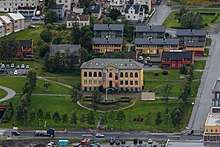
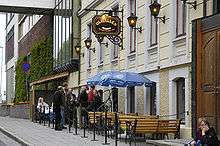
Being the largest city in Northern Norway, Tromsø is a cultural centre for its region. It gained some international attention when on 11 June 2005 hosted one of six 46664 concerts, designed to put work concerning HIV/AIDS on the international agenda.
Many cultural activities take place in Kulturhuset (English: lit. the culture house), including concerts by Tromsø Symphony Orchestra and plays by Tromsø's professional theatre troupe, Hålogaland Teater. The new theatre building was opened in November 2005. The city contains several museums. The largest are the Northern Norwegian Art Gallery (Nordnorsk Kunstmuseum) and the Tromsø Gallery of Contemporary Art (Tromsø Kunstforening).
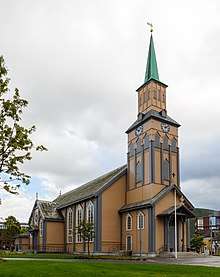
The Tromsø techno scene is the origin of many of Norway's most important artists in electronic music, and Tromsø was a leading city at the early stages of the house and techno scene in Norway from the last part of the 1980s.[80] The internationally recognized duo Röyksopp and the ambient electronic musician Geir Jennsen, known as Biosphere, are the most famous exports.
The record label Beatservice Records and the Insomnia Festival means Tromsø still leads the country in the development and promotion of the genre.
The local newspapers are Bladet Tromsø and Nordlys.
Festivals and celebrations
Both the Tromsø International Film Festival and Nordlysfestivalen (lit. the Aurora Borealis Festival), a classical music festival, are arranged in January. The end of that month is marked by the Day of the Sun (Soldagen), when the sun finally appears above the horizon after the Polar Night, which is celebrated, mainly by children. The International Day of the Sami People is celebrated at the University of Tromsø and the city hall on 6 February every year. Tromsø's Latin American Festival, No Siesta Fiesta, is held at the end of February. It started in 2007 and showcases "the best of Latin America" in Northern Norway with film, dance, music, art, seminars, debates, markets, and a street Samba parade. Every autumn the Insomnia Festival for electronic music is hosted. It is one of the largest and most important festivals for electronic music and techno culture in Norway.
The Bukta Tromsø Open Air Festival, held in June and July, is a popular music festival. The Bukta festival is mainly a rock festival, but also features other kinds of modern music. The festival takes place in Telegrafbukta, a park on the south-western part of the Tromsøya island. Other popular cultural summer events among the population of Tromsø is the Karlsøy festival and the Riddu Riddu festival, both held in the region surrounding the city.
Sports
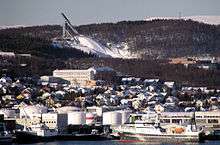
Tromsø is the home of many football clubs, of which the three most prominent are Tromsø IL, which plays in the Norwegian Premier League and is the world's northernmost Premier League football team, I.F. Fløya in the Norwegian First Division (women), and Tromsdalen U.I.L., playing in the Adeccoliga. Tromsø Midnight Sun Marathon is arranged every year in June and recently also a Polar Night Halfmarathon in January. The city is home to many clubs in the top division in various sports. Most notably basketball-outfit Tromsø Storm in the BLNO, BK Tromsø in the top volleyball league for men, and Tromsø Volley in the top volleyball league for women. The oldest sports club in Tromsø is Tromsø Turnforening, a gymnastics club founded in 1862, that also was the cradle of the before mentioned football club Tromsø IL.
Tromsø was selected by the Norwegian National Olympic Committee as Norway's candidate for the 2018 Winter Olympics. This would have made Tromsø the first city north of the Arctic Circle to host the games. There were plans to use ships as the media village. In October 2008 the NOC suspended Tromsø's bid, citing excessive costs.[81] From the southern to the northern tip of the island Tromsøya, there is a floodlit cross country ski track. A ski jump is also situated on the island, close to the university. As of the spring in 2010, the city's first ice rink has been open and is home to Tromsø Hockey, which plays in the Swedish Ice Hockey Association's League 3. Tromsø is also home to the most northern tennis club in Norway.
Notable residents
- Arthur Arntzen – writer and entertainer
- Svein Berge and Torbjørn Brundtland – musicians, Röyksopp
- Anneli Drecker and band Bel Canto – musicians
- Espen Sommer Eide – musician with the musical group Alog
- Gerd Fleischer (born 1942) – human rights activist
- Ailo Gaup – professional motocross rider who invented the Underflip
- D. Carleton Gajdusek (1923–2008) – won a Nobel Prize for work on prion diseases
- Mads Gilbert – anaesthesiologist and humanitarian activist
- Jan Thore Grefstad – rock singer
- Dag-Are Haugan – musician with the musical group Alog
- Tomas Haugen (Samoth) – guitarist, bassist, and drummer for black metal band Emperor
- Einar Hoidale – lawyer, United States House of Representatives from Minnesota
- Geir Jenssen – electronica musician
- Halvdan Koht – historian, politician and former head of the Ministry of Foreign Affairs
- Hermann Kristoffersen – "Red Hermann", A former long-serving mayor of Tromsø
- Espen Lind – musician, songwriter, producer and multi-instrumentalist
- Lene Marlin – musician and songwriter
- Henry Rudi – trapper and polar-bear hunter
- Cora Sandel – writer (pseudonym for Sara Fabricius)
- Erik Skjoldbjærg – director
- James Trane – founder of Trane, La Crosse, Wisconsin
- Peter Wessel Zapffe – author and existentialist philosopher
- Dagny Norvoll Sandvik – pop musician and songwriter
International relations
Twin towns – Sister cities
| City[82] | Country | Year |
|---|---|---|
| Finland | 1940 | |
| Sweden | 1950 | |
| Grimsby | England | 1961 |
| United States | 1969 | |
| Croatia[83] | 1971 | |
| Russia | 1972 | |
| Guatemala | 1999 | |
| Gaza City | State of Palestine | 2001 |
| Russia | 2011 |
References
- "Navn på steder og personer: Innbyggjarnamn" (in Norwegian). Språkrådet.
- "Forskrift om målvedtak i kommunar og fylkeskommunar" (in Norwegian). Lovdata.no.
- Wells, John C. (2008). Longman Pronunciation Dictionary (3rd ed.). Longman. ISBN 978-1-4058-8118-0.
- "Tromsø". Oxford Dictionaries UK Dictionary. Oxford University Press. Retrieved May 17, 2019.
- Erroneously, the Sámi name is often believed to be "Romssa". This is because "Tromsø Municipality" is "Romssa Suohkan". Romssa, however is the genitive case, so that "Romssa Suohkan" translates to "the Municipality of Romsa".
- Statistisk sentralbyrå (2020). "Table: 06913: Population 1 January and population changes during the calendar year (M)" (in Norwegian).
- Statistisk sentralbyrå (2020). "09280: Area of land and fresh water (km²) (M)" (in Norwegian).
- "Unike steinalderfunn" (in Norwegian Bokmål). nrk.no. 2011-07-27. Retrieved 2013-08-21.
- "British Museum - Collection online - Search: Tromso". British Museum. Retrieved 9 June 2014.
- "Ottar fortalte om det ukjente "Norge" - Magasinet". Dagbladet.no. 2009-08-18. Retrieved 2012-02-16.
- "2 Samisk tilstedeværelse..." regjeringen.no. Retrieved 2012-02-16.
- "Sør-Kvaløya - fornminner — Kulturminneaaret 2009" (in Norwegian). Loype.kulturminneaaret2009.no. Archived from the original on 1 May 2012. Retrieved 2012-02-16.
- "Diplomatarium Norvegicum b.1 nr.112, the Papal letter (in Latin) first referring to Troms". Dokpro.uio.no. Retrieved 2012-11-22.
- "Biskoper i Hålogaland bispedømme 1804-1952". Den Norske Kirke. Archived from the original on 9 October 2007. Retrieved 3 November 2011.
- Statsarkivet i Tromsø 1992: Arkivkatalog TROMSØ OFFENTLIGE LÆRERSKOLE, page 6.
- "Om museet" (in Norwegian). Universitet i Tromsø. Archived from the original on 3 November 2007. Retrieved 2007-11-03.
- "Fra ølvogn til mikrobryggeri". Macks Ølbryggeri AS. Retrieved 2007-11-03.
- "Destinasjon Tromsø - Facts about Tromsø". Destinasjontromso.no. Archived from the original on 9 October 2011. Retrieved 2012-11-22.
- "Tromsø, Norway - Lindblad Expeditions". www.expeditions.com. Retrieved 2019-09-28.
- Bomann-Larsen, Tor, 1951- (2006). Roald Amundsen. Stroud: Sutton. ISBN 0750943432. OCLC 69022308.CS1 maint: multiple names: authors list (link)
- "Lost heroes of the 'Tirpitz'". BBC History. BBC. 17 February 2011. Retrieved 21 August 2018.
- "World War II Database". Retrieved 21 August 2018.
- 617 Squadron - The Operational Record Book 1943 - 1945 "Archived copy" (PDF). Archived from the original (PDF) on 2010-12-06. Retrieved 2008-08-04.CS1 maint: archived copy as title (link) http://www.dambusters.org with additional information by Tobin Jones; Binx Publishing, Pevensey House, Sheep Street, Bicester. OX26 6JF. Acknowledgement is given to HMSO as holders of the copyright on the Operational Record Book
- Derry, T.K. (1972). A History of Modern Norway: 1814—1972. Clarendon Press, Oxford. ISBN 0-19-822503-2.
- "1902 Tromsø. Population 1 January and population changes during the year. 1951-". Statistics Norway. 2007. Retrieved 2007-11-03.
- Statistics Norway (1 January 2011). "Urban settlements. Population and area, by municipality". Archived from the original on 25 November 2011. Cite journal requires
|journal=(help) - Jukvam, Dag (1999). "Historisk oversikt over endringer i kommune- og fylkesinndelingen" (PDF) (in Norwegian). Statistisk sentralbyrå.
- "TROMSØ". Arkivverket.no. 1941-09-24. Retrieved 2010-06-24.
- Slavomir.P. "Coats-of-arms - National Archival services of Norway". Riksarkivet.no. Archived from the original on 2012-02-27. Retrieved 2012-11-22.
- "Civic heraldry of Norway - Norske Kommunevåpen". Heraldry of the World. Retrieved 2018-08-14.
- "Botanisk hage i Tromsø" [Botanical Garden in Tromsø]. The Arctic University of Norway. Retrieved 2017-02-25.
- NordNorsk.Vitensenter.no Archived 2005-12-28 at the Wayback Machine (in Norwegian)
- "Bli rik på grønn jul", "Våt jul i snøbyen!"
- Norwegian Meteorological Institute's eklima site
- "Tromsø (Troms)". met.no. Retrieved 2017-02-25.
- "Coldest temperature in February". Yr.no. Retrieved 22 November 2012.
- "Tromsø official climate statistics". Retro.met.no. 28 January 2008. Archived from the original on 2012-07-17. Retrieved 22 November 2012.
- "Tromsø (Troms)". June 2013.
- "Climate Statistics for Tromsø, Norway (1961-1990)". November 2011.
- "Moyennes 1981-2010 Norvége" (in French). Retrieved 11 January 2017.
- "Tromsø, Norway - Monthly weather forecast and Climate data". Weather Atlas. Retrieved 3 July 2019.
- "Tromsø er "djevelsk stygg" - VG Nett om Reiselivsnyheter" (in Norwegian). Vg.no. 2008-08-21. Retrieved 2010-05-29.
- Carina Hansen. "Forfall i hele byen - iTromsø" (in Norwegian). Itromso.no. Retrieved 2010-05-29.
- Hansen, Tore, ed. (2016-05-12). "kommunestyre". Store norske leksikon (in Norwegian). Kunnskapsforlaget. Retrieved 2018-08-07.
- "Tall for Norge: Kommunestyrevalg 2019 - Troms og Finnmark". Valg Direktoratet. Retrieved 2019-10-26.
- "Table: 04813: Members of the local councils, by party/electoral list at the Municipal Council election (M)" (in Norwegian). Statistics Norway.
- "Tall for Norge: Kommunestyrevalg 2011 - Troms Romsa". Valg Direktoratet. Retrieved 2019-10-26.
- "Kommunestyrevalget 1995" (PDF) (in Norwegian). Oslo-Kongsvinger: Statistisk sentralbyrå. 1996. Retrieved 2020-03-18.
- "Kommunestyrevalget 1991" (PDF) (in Norwegian). Oslo-Kongsvinger: Statistisk sentralbyrå. 1993. Retrieved 2020-03-18.
- "Kommunestyrevalget 1987" (PDF) (in Norwegian). Oslo-Kongsvinger: Statistisk sentralbyrå. 1988. Retrieved 2020-03-18.
- "Kommunestyrevalget 1983" (PDF) (in Norwegian). Oslo-Kongsvinger: Statistisk sentralbyrå. 1984. Retrieved 2020-03-18.
- "Kommunestyrevalget 1979" (PDF) (in Norwegian). Oslo: Statistisk sentralbyrå. 1979. Retrieved 2020-03-18.
- "Kommunevalgene 1975" (PDF) (in Norwegian). Oslo: Statistisk sentralbyrå. 1977. Retrieved 2020-03-18.
- "Kommunevalgene 1972" (PDF) (in Norwegian). Oslo: Statistisk sentralbyrå. 1973. Retrieved 2020-03-18.
- "Kommunevalgene 1967" (PDF) (in Norwegian). Oslo: Statistisk sentralbyrå. 1967. Retrieved 2020-03-18.
- "Kommunevalgene 1963" (PDF) (in Norwegian). Oslo: Statistisk sentralbyrå. 1964. Retrieved 2020-03-18.
- "Kommunevalgene og Ordførervalgene 1959" (PDF) (in Norwegian). Oslo: Statistisk sentralbyrå. 1960. Retrieved 2020-03-18.
- "Kommunevalgene og Ordførervalgene 1955" (PDF) (in Norwegian). Oslo: Statistisk sentralbyrå. 1957. Retrieved 2020-03-18.
- "Kommunevalgene og Ordførervalgene 1951" (PDF) (in Norwegian). Oslo: Statistisk sentralbyrå. 1952. Retrieved 2020-03-18.
- "Kommunevalgene og Ordførervalgene 1947" (PDF) (in Norwegian). Oslo: Statistisk sentralbyrå. 1948. Retrieved 2020-03-18.
- "Kommunevalgene og Ordførervalgene 1945" (PDF) (in Norwegian). Oslo: Statistisk sentralbyrå. 1947. Retrieved 2020-03-18.
- "Kommunevalgene og Ordførervalgene 1937" (PDF) (in Norwegian). Oslo: Statistisk sentralbyrå. 1938. Retrieved 2020-03-18.
- "Kommunevalgene og Ordførervalgene 1934" (PDF) (in Norwegian). Oslo: Statistisk sentralbyrå. 1935. Retrieved 2020-03-18.
- "Kommunevalgene og Ordførervalgene 1931" (PDF) (in Norwegian). Oslo: Statistisk sentralbyrå. 1932. Retrieved 2020-03-18.
- "Kommunevalgene og Ordførervalgene 1928" (PDF) (in Norwegian). Oslo: Statistisk sentralbyrå. 1929. Retrieved 2020-03-18.
- "Kommunevalgene og Ordførervalgene 1925" (PDF) (in Norwegian). Oslo: Statistisk sentralbyrå. 1926. Retrieved 2020-03-18.
- "Kommunevalgene og Ordførervalgene 1922" (PDF) (in Norwegian). Oslo: Statistisk sentralbyrå. 1923. Retrieved 2020-03-18.
- "Kommunevalgene og Ordførervalgene 1919" (PDF) (in Norwegian). Oslo: Statistisk sentralbyrå. 1920. Retrieved 2020-03-18.
- "Kommunevalgene og Ordførervalgene 1916" (PDF) (in Norwegian). Oslo: Statistisk sentralbyrå. 1917. Retrieved 2020-03-18.
- "Befolkningen i Tromsø kommune etter statsborgerskap 1.1. 2005 og 1.1. 2006" [Population of the municipality of Tromsø by nationality from 1 January 2005 to 1 January 2006]. InterInfo Tromsø municipality (in Norwegian). 2006. Archived from the original on 30 October 2007. Retrieved 6 July 2007.
- "Broen 2004 no.3". Broen. Norwegian Catholic Church. 2004. Retrieved 6 July 2007 – via issuu.
- "09817: Immigrants and Norwegian-born to immigrant parents, by immigration category, country background and percentages of the population 2010 - 2018". Statistics Norway.
- Informasjonstjenesten (2 February 2006). "Samefolkets dag i Tromsø" [Sámi People's Day in Tromsø]. Tromsø Kommune (in Norwegian). Archived from the original on 14 May 2012. Retrieved 2012-02-16.
- "Tromsø 2018 (2006-2008) - i-Tromsø". Itromso.canalblog.com. Retrieved 2012-02-16.
- "Nå blir Tromsø samisk område". Politisk.tv2.no. 16 June 2011. Archived from the original on 5 April 2012. Retrieved 2012-02-16.
- "Vrenger kofta i protest mot same-snuoperasjon | TV 2 Play". Tv2.no. 2011-11-05. Archived from the original on 6 November 2011. Retrieved 2012-02-16.
- "Vrenger kofta i protest mot samisk-nei - TV 2 Nyhetene". Tv2.no. Retrieved 2012-02-16.
- Fjellheim, Skjalg (2011-02-09). "Tromsø er ingen sameby - NRK". NRK. Archived from the original on 9 May 2012. Retrieved 2012-02-16.
- "Lar seg ikke knekke - NRK Sápmi - NRK". Nrk.no. 2011-11-17. Retrieved 2012-02-16.
- "20 år med techno". Aftenposten. 26 November 2004. Archived from the original on 29 June 2011. Retrieved 6 July 2007.
- Tromsø's Application Withdrawn - Aftenposten.no Archived October 7, 2008, at the Wayback Machine
- "Vennskapsbyer" (official website). Tromsø, Norway: Tromsø municipality. Archived from the original on 2012-08-14. Retrieved 2014-12-01.
- "Intercity and International Cooperation of the City of Zagreb". © 2006-2009 City of Zagreb. Retrieved 2009-06-23.
External links
- Municipal fact sheet from Statistics Norway (in Norwegian)
| Wikimedia Commons has media related to Tromsø. |
| Wikisource has the text of the 1911 Encyclopædia Britannica article Tromsö. |

- Tromsø Municipal Council


